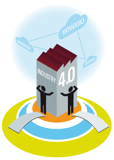The Importance of S&OP: A Review
Nick Ostdick - April 19, 2016

 It wasn’t too far in the past when S&OP (sales and operations planning) processes and software were not the fulcrum of discussion and theory they are today. In the current manufacturing and supply industries, S&OP is recognized as a crucial driver in efficient supply chain management, especially as the supply stream diversifies across the globe reaching new and emerging markets. Today powerful computing and software systems allow companies to achieve end-to-end visibility and transparency, and robust S&OP practices are a key driver in reaching these benchmarks.
It wasn’t too far in the past when S&OP (sales and operations planning) processes and software were not the fulcrum of discussion and theory they are today. In the current manufacturing and supply industries, S&OP is recognized as a crucial driver in efficient supply chain management, especially as the supply stream diversifies across the globe reaching new and emerging markets. Today powerful computing and software systems allow companies to achieve end-to-end visibility and transparency, and robust S&OP practices are a key driver in reaching these benchmarks.
But there’s also a great incongruity in the acceptance of S&OP solutions, especially as the associated concepts of S&OP evolve into a new generation of sales and planning referred to as IBP (Integrated Business Management), which we’ll discus in part two of this entry. And this discord revolves around the importance companies place on leveraging sales and planning software and solutions versus the percentage of companies who are actually equipped to implement S&OP technologies.
For example, take a recent survey conducted by Supply Chain Trends that showed 40 percent of companies surveyed cited major technological and software complications in implementing sales and planning solutions. Contrast that with a report issued by Supply Chain Management Review in which companies surveyed said they allocate roughly 70 percent of their S&OP budget on developing and implementing new technologies.
There appears to be a great disharmony in how companies view the value of implementing sales and planning software with their readiness to do so, so in part one of this two-part series on sales and planning propositions and the future of S&OP strategies, we’re going to conduct a crash course review 3 benefits of S&OP solutions and why companies would be well-advised to close the gap between understanding and action in terms of sales and planning processes and the impact on a company’s vitality.
1). First, even in 2016, too many companies still rely on the spreadsheet model to gather, aggregate, review, and share data points that are too crucial to leave to the potentiality of miscalculation and other brands of human error. S&OP software solutions not only automate data mining and reporting for immediate analysis and distribution to those throughout the manufacturing and supply stream, but these systems also centralize data entry and reporting points; reduce waste in time and resources associated with manually gathering and compiling data; and allow for real-time reporting to help manufacturing and supply managers make in-the-moment, cost-effective decisions from inventory to retail settings.
2). Ask any manufacturing, supply, or freight manager what their ideal superpower would be, and most would probably choose the ability to see into and predict the future. While S&OP solutions probably won’t help you pick winning lottery numbers, sales and planning technologies do provide companies with the capability to run ‘what if?’ simulations and scenarios to create detailed forecasting and predictive models. These models, along with the capacity to pull and review data based on past supply and demand analytics, allow companies to craft proactive strategies to manage future inventory and supply to meet market demands. S&OP software solutions also lend to greater supply transparency as employees at any point of the value chain can access reporting and forecasting and distribute this data to those inside and out of the traditional supply chain model.
3). If up-to-date data, information, and analytics capabilities are king among the priorities of manufacturing, supply, and freight companies, then S&OP can provide these companies with the keys to the castle in terms of gathering and interpreting metrics to gauge everything from future demand for products to overall company performance. Sales and planning solutions create a greater understanding about the numbers and benchmarks to achieve across functional groups in order to increase communication and collaboration throughout the supply stream. In essence, a well-conceived S&OP strategy and solution makes it easy for the left hand to talk to the right, and for those within the supply network to review and analyze such potential pain points as pricing and cost data, marketing plans, financial targets, and more. Utilizing this data will ultimately create greater end-to-end visibility and help customers leverage opportunities for sustainable growth.
As the global manufacturing and trade market expands, companies will require greater breadth and scope in their sales and planning solutions. In addition, as companies continue to digitize and operate in cloud-based systems, the ripple effect of robust S&OP solutions will be felt throughout an entire company as opposed to being relegated to supply and distribution platforms.
As such, in our next post we’ll discuss the future of S&OP strategy and concepts and how companies can leverage new technologies and world-views to stay competitive and profitable.
LATEST POSTS
- Understand Circular Economy in The Manufacturing Industry
- How Can Industry 4.0 IT Integration Be Achieved Smoothly?
- The Significance of Order Sequencing in Discrete Manufacturing
- How to improve your Supply Chain Management: The Power of Control Towers
- Optimizing Human Resource Scheduling in Manufacturing: A Technological Approach



